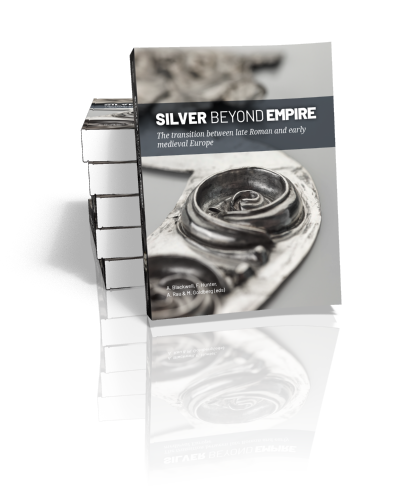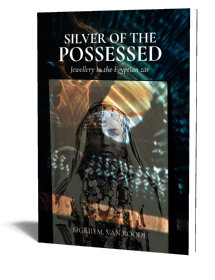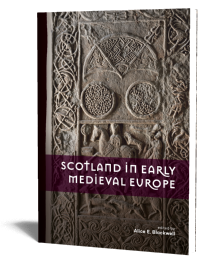Silver Beyond Empire
The transition between late Roman and early medieval Europe
Edited by Alice E. Blackwell, Fraser Hunter, Andreas Rau & Martin Goldberg | Forthcoming

Silver Beyond Empire
The transition between late Roman and early medieval Europe
Edited by Alice E. Blackwell, Fraser Hunter, Andreas Rau & Martin Goldberg | Forthcoming
Paperback ISBN: 9789464264098 | Hardback ISBN: 9789464264104 | Imprint: Sidestone Press | Format: 210x280mm | 440 pp. | Language: English | 73 illus. (bw) | 666 illus. (fc) | Keywords: Late Roman; early medieval; silver; hacksilver; transition; status; Britain; Europe | download cover | DOI: 10.59641/k1n7h8i9j0 | CC-license: CC BY 4.0
Publication date: 18-12-2025
-
Digital & Online access
Digital/Online version not (yet) available
-
Buy via Sidestone (EU & UK)
Get €5.00 discount on forthcoming books by using coupon code "PRE-ORDER" in your shopping cart!
-
Buy via our Distributors (WORLD)
For non-EU or UK destinations you can buy our books via our international distributors. Although prices may vary this will ensure speedy delivery and reduction in shipping costs or import tax. But you can also order with us directly via the module above.
For UK & other International destinations
For USA/Canada & other International destinations
-
Bookinfo
Paperback ISBN: 9789464264098 | Hardback ISBN: 9789464264104 | Imprint: Sidestone Press | Format: 210x280mm | 440 pp. | Language: English | 73 illus. (bw) | 666 illus. (fc) | Keywords: Late Roman; early medieval; silver; hacksilver; transition; status; Britain; Europe | download cover | DOI: 10.59641/k1n7h8i9j0 | CC-license: CC BY 4.0
Publication date: 18-12-2025

We will plant a tree for each order containing a paperback or hardback book via OneTreePlanted.org.
Power and prestige in Europe during the first millennium AD were predominantly expressed in two portable materials: silver and gold. These precious metals underpinned the emergence of early Medieval kingdoms in Europe by providing the raw materials for objects that were used to create, contest and reflect status within and between societies. They also provide a key source of evidence for understanding reactions to the political vacuum caused by the disintegration of the Roman Empire and the emergence of the early Medieval kingdoms of Europe.
While parts of temperate Europe favoured gold, silver was the most important precious metal in northern Britain for over 700 years (c.200–900). Silver was introduced to Scotland by Rome (via subsidies, military pay, diplomacy and loot), first as denarii and later as hacksilver, and rapidly became a vital means of expressing power and prestige in the lands beyond this frontier. Indeed, silver’s Imperial connotations may have been a key part of its attraction. The supply of silver declined with the diminishing influence of the western Roman Empire and this dwindling resource needed to be carefully managed and recycled by early Medieval societies.
Together National Museums Scotland and Leibniz-Zentrum für Archäologie created an international research network of specialists working on silver from the 4th–6th centuries with a focus on the North Sea region. This volume of papers results from meetings of the network in Edinburgh and Schleswig that explored the role of silver in the crucial transition from the late Roman Empire, with barbaricum beyond its frontiers, to early Medieval Europe and the peoples and polities that many modern European nations trace their origins back to. It aims to provide the first comparative, international and cross-disciplinary study of this powerful and valuable material during a pivotal period in Europe’s history. It also provides the first full catalogues of a number of important but poorly understood hacksilver hoards from the UK: Norrie’s Law (Fife), Gaulcross (Aberdeenshire), Tummel Bridge (Perthshire) and Patching (Sussex).
Chapter 1. The circulation of Roman silver in the 4th and 5th centuries around and across the frontier
Fraser Hunter
Chapter 2. Silver for the Soldiers: quantifying the use and absence of silver among the limitanei of the dux Britanniarum
Rob Collins
Chapter 3. Hacksilver hoarding and silver use in 5th/6th-century Scotland
Alice Blackwell & Martin Goldberg
Chapter 4. Silver in the societies of Roman Iron Age and Migration Period Scandinavia – with a focus on hacksilver of the 4th–6th centuries
Andreas Rau
Chapter 5. Denarii in late Roman and Migration Period hoards
Aleksander Bursche & Kyrylo Myzgin
Chapter 6. Silver in the Merovingian realm: a post-monetary economy between the late Roman and the Carolingian Empire
Dieter Quast
Chapter 7. Hacksilver in late Antiquity, the Merovingian period and Slavic times. Structural similarities or continuity?
Matthias Hardt
Chapter 8. Object biographies of silver objects in the Quoit Brooch Style of south-east Britain: manufacture, use and reuse
Ellen Swift
Chapter 9. Patching, West Sussex: the nature of the hacksilver and the date of the hoard
Fraser Hunter & Andreas Rau
Chapter 10. The early medieval hacksilver hoard from Wem, Shropshire
Roger H. White, Richard Hobbs & Richard Abdy
Chapter 11. Scotland’s silver spiral rings in context
Jenna Martin
Chapter 12. A reconsideration of silver handpins
Susan Youngs
Chapter 13. Hillquarter and the Norrie’s Law and Gaulcross mounts: saddle or shield?
Joanna Close-Brooks
Chapter 14. The siliquae from Gaulcross and Norrie’s Law in context
Richard Abdy
Chapter 15. The scientific examination and analysis of the Gaulcross and Norrie’s Law silver hoards
Lore Troalen, Janet Lang & Jim Tate
Chapter 16. Silver-working at the Craw Stane complex, Rhynie in north-east Scotland
Gemma Cruickshanks & Gordon Noble
Catalogue 1: The Norrie’s Law hoard, Fife, Scotland
Alice Blackwell & Fraser Hunter, with Richard Abdy & Martin Goldberg
Catalogue 2: The Gaulcross hoard, Aberdeenshire, Scotland
Alice Blackwell & Fraser Hunter, with Richard Abdy
Catalogue 3: The Tummel Bridge hoard, Perthshire, Scotland
Alice Blackwell & Fraser Hunter
Catalogue 4: The Patching hacksilver, West Sussex, England
Fraser Hunter
Catalogue 5: The Wem hoard, Shropshire, England
Roger H White, Richard Hobbs & Richard Abdy
Catalogue 6: The ‘Cavan’ bangle, Armargh, Northern Ireland
Alice Blackwell
Technical appendix 1: Technological observations of the Gaulcross silver
Lore Troalen, Julia Novion Ducassou & Janet Lang
Technical appendix 2: Investigation of a selection of objects from the Gaulcross and Norrie’s Law silver hoards
Lore Troalen & Janet Lang
Technical appendix 3: Quantitative analysis of a selection of Gaulcross and Norrie’s Law silver fragments by particle-induced X-ray emission analysis
Lore Troalen, Jim Tate & Quentin Lemasson
Technical appendix 4: Surface analysis of the Norrie’s Law silver by X-ray fluorescence
Data by Susy Kirk, with interpretation and text by Lore Troalen
Dr. Alice E. Blackwell
Alice Blackwell is Senior Curator of Medieval archaeology & history at National Museums Scotland and works on the material culture of the early, central and later middle ages. She has co-authored several books – Early Medieval Scotland: Individuals, Communities and Ideas (2012) and Scotland’s early silver (2017) which developed from a special exhibition she jointly curated in Edinburgh. She also edited Scotland in early Medieval Europe (2018).
Dr. Fraser Hunter
Fraser Hunter is principal curator of Iron Age and Roman collections at National Museums Scotland. His research work focuses around understanding Iron Age decorative metalwork (“Celtic art”) in its European context and the impact of the Roman world on the peoples of Scotland. He recently co-edited a new appraisal of the Traprain Treasure (2022), the largest hoard of Roman hacksilver from anywhere within or beyond the Empire. He co-curated Scotland’s early silver and Celts (2015), a major exhibition developed in partnership with the British Museum.
Dr. Andreas Rau
Andreas Rau is a Senior Researcher at Leibniz-Zentrum für Archäologie (previously Centre for Baltic and Scandinavian Archaeology) in Schleswig, Germany. Andreas has published widely on Iron Age, Roman and Migration period archaeology including on hacksilver hoarding in southern Scandinavia, and on the deposits at Nydam, Denmark. He has curated displays on the Nydam ships in Schleswig.
Dr. Martin Goldberg
Martin Goldberg is Principal Curator of Medieval archaeology and history at National Museums Scotland. Martin works on early medieval and viking-age material culture and co-curated Celts and Scotland’s early silver. He is currently leading a major project on the viking-age Galloway hoard in collaboration with the University of Glasgow.
Abstract:
Power and prestige in Europe during the first millennium AD were predominantly expressed in two portable materials: silver and gold. These precious metals underpinned the emergence of early Medieval kingdoms in Europe by providing the raw materials for objects that were used to create, contest and reflect status within and between societies. They also provide a key source of evidence for understanding reactions to the political vacuum caused by the disintegration of the Roman Empire and the emergence of the early Medieval kingdoms of Europe.
While parts of temperate Europe favoured gold, silver was the most important precious metal in northern Britain for over 700 years (c.200–900). Silver was introduced to Scotland by Rome (via subsidies, military pay, diplomacy and loot), first as denarii and later as hacksilver, and rapidly became a vital means of expressing power and prestige in the lands beyond this frontier. Indeed, silver’s Imperial connotations may have been a key part of its attraction. The supply of silver declined with the diminishing influence of the western Roman Empire and this dwindling resource needed to be carefully managed and recycled by early Medieval societies.
Together National Museums Scotland and Leibniz-Zentrum für Archäologie created an international research network of specialists working on silver from the 4th–6th centuries with a focus on the North Sea region. This volume of papers results from meetings of the network in Edinburgh and Schleswig that explored the role of silver in the crucial transition from the late Roman Empire, with barbaricum beyond its frontiers, to early Medieval Europe and the peoples and polities that many modern European nations trace their origins back to. It aims to provide the first comparative, international and cross-disciplinary study of this powerful and valuable material during a pivotal period in Europe’s history. It also provides the first full catalogues of a number of important but poorly understood hacksilver hoards from the UK: Norrie’s Law (Fife), Gaulcross (Aberdeenshire), Tummel Bridge (Perthshire) and Patching (Sussex).
Contents
Chapter 1. The circulation of Roman silver in the 4th and 5th centuries around and across the frontier
Fraser Hunter
Chapter 2. Silver for the Soldiers: quantifying the use and absence of silver among the limitanei of the dux Britanniarum
Rob Collins
Chapter 3. Hacksilver hoarding and silver use in 5th/6th-century Scotland
Alice Blackwell & Martin Goldberg
Chapter 4. Silver in the societies of Roman Iron Age and Migration Period Scandinavia – with a focus on hacksilver of the 4th–6th centuries
Andreas Rau
Chapter 5. Denarii in late Roman and Migration Period hoards
Aleksander Bursche & Kyrylo Myzgin
Chapter 6. Silver in the Merovingian realm: a post-monetary economy between the late Roman and the Carolingian Empire
Dieter Quast
Chapter 7. Hacksilver in late Antiquity, the Merovingian period and Slavic times. Structural similarities or continuity?
Matthias Hardt
Chapter 8. Object biographies of silver objects in the Quoit Brooch Style of south-east Britain: manufacture, use and reuse
Ellen Swift
Chapter 9. Patching, West Sussex: the nature of the hacksilver and the date of the hoard
Fraser Hunter & Andreas Rau
Chapter 10. The early medieval hacksilver hoard from Wem, Shropshire
Roger H. White, Richard Hobbs & Richard Abdy
Chapter 11. Scotland’s silver spiral rings in context
Jenna Martin
Chapter 12. A reconsideration of silver handpins
Susan Youngs
Chapter 13. Hillquarter and the Norrie’s Law and Gaulcross mounts: saddle or shield?
Joanna Close-Brooks
Chapter 14. The siliquae from Gaulcross and Norrie’s Law in context
Richard Abdy
Chapter 15. The scientific examination and analysis of the Gaulcross and Norrie’s Law silver hoards
Lore Troalen, Janet Lang & Jim Tate
Chapter 16. Silver-working at the Craw Stane complex, Rhynie in north-east Scotland
Gemma Cruickshanks & Gordon Noble
Catalogue 1: The Norrie’s Law hoard, Fife, Scotland
Alice Blackwell & Fraser Hunter, with Richard Abdy & Martin Goldberg
Catalogue 2: The Gaulcross hoard, Aberdeenshire, Scotland
Alice Blackwell & Fraser Hunter, with Richard Abdy
Catalogue 3: The Tummel Bridge hoard, Perthshire, Scotland
Alice Blackwell & Fraser Hunter
Catalogue 4: The Patching hacksilver, West Sussex, England
Fraser Hunter
Catalogue 5: The Wem hoard, Shropshire, England
Roger H White, Richard Hobbs & Richard Abdy
Catalogue 6: The ‘Cavan’ bangle, Armargh, Northern Ireland
Alice Blackwell
Technical appendix 1: Technological observations of the Gaulcross silver
Lore Troalen, Julia Novion Ducassou & Janet Lang
Technical appendix 2: Investigation of a selection of objects from the Gaulcross and Norrie’s Law silver hoards
Lore Troalen & Janet Lang
Technical appendix 3: Quantitative analysis of a selection of Gaulcross and Norrie’s Law silver fragments by particle-induced X-ray emission analysis
Lore Troalen, Jim Tate & Quentin Lemasson
Technical appendix 4: Surface analysis of the Norrie’s Law silver by X-ray fluorescence
Data by Susy Kirk, with interpretation and text by Lore Troalen
Dr. Alice E. Blackwell
Alice Blackwell is Senior Curator of Medieval archaeology & history at National Museums Scotland and works on the material culture of the early, central and later middle ages. She has co-authored several books – Early Medieval Scotland: Individuals, Communities and Ideas (2012) and Scotland’s early silver (2017) which developed from a special exhibition she jointly curated in Edinburgh. She also edited Scotland in early Medieval Europe (2018).
Dr. Fraser Hunter
Fraser Hunter is principal curator of Iron Age and Roman collections at National Museums Scotland. His research work focuses around understanding Iron Age decorative metalwork (“Celtic art”) in its European context and the impact of the Roman world on the peoples of Scotland. He recently co-edited a new appraisal of the Traprain Treasure (2022), the largest hoard of Roman hacksilver from anywhere within or beyond the Empire. He co-curated Scotland’s early silver and Celts (2015), a major exhibition developed in partnership with the British Museum.
Dr. Andreas Rau
Andreas Rau is a Senior Researcher at Leibniz-Zentrum für Archäologie (previously Centre for Baltic and Scandinavian Archaeology) in Schleswig, Germany. Andreas has published widely on Iron Age, Roman and Migration period archaeology including on hacksilver hoarding in southern Scandinavia, and on the deposits at Nydam, Denmark. He has curated displays on the Nydam ships in Schleswig.
Dr. Martin Goldberg
Martin Goldberg is Principal Curator of Medieval archaeology and history at National Museums Scotland. Martin works on early medieval and viking-age material culture and co-curated Celts and Scotland’s early silver. He is currently leading a major project on the viking-age Galloway hoard in collaboration with the University of Glasgow.
-
Digital & Online access
Digital/Online version not (yet) available
-
Buy via Sidestone (EU & UK)
Get €5.00 discount on forthcoming books by using coupon code "PRE-ORDER" in your shopping cart!
-
Buy via our Distributors (WORLD)
For non-EU or UK destinations you can buy our books via our international distributors. Although prices may vary this will ensure speedy delivery and reduction in shipping costs or import tax. But you can also order with us directly via the module above.
For UK & other International destinations
For USA/Canada & other International destinations
- Browse all books by subject
-
Search all books

We will plant a tree for each order containing a paperback or hardback book via OneTreePlanted.org.
You might also like:
© 2025 Sidestone Press KvK nr. 28114891 Privacy policy Sidestone Newsletter Terms and Conditions (Dutch)








